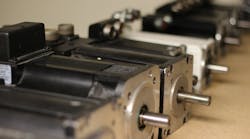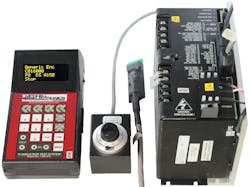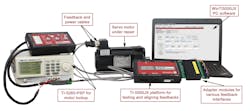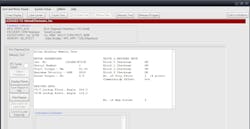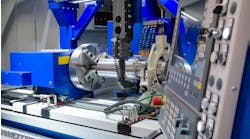Q&A: Understanding How to Test and Repair Servo Motors
Servo motors can be used in a range of applications, and like any component, will wear over time. Understanding how to test and repair them can ensure longevity of the servo motors themselves as well as reduce downtime for the machines into which they are integrated.
Contributor Robert Farell spoke with Stuart Mitchell, Vice President of Mitchell Electronics Inc., about testing and repair of servo motors. Mitchell Electronics develops test products for encoders and servo motors, serving industries in which brushless servo motors often fail or require more regular maintenance and troubleshooting due to heavy use or extreme environmental conditions. This includes manufacturing industries such as automotive, aerospace, food services, consumer packaged goods, and robotics.
Mitchell offers his insight into common causes of servo motor malfunctions as well as how best to test and repair motors to help maintain productivity.
Robert Farell (RF): What are the advantages of brushless servo motors?
Stuart Mitchell (SM): Brushless servo motors offer substantial power in a relatively small package and are more energy efficient than earlier motors. They are often coupled with high resolution encoders enabling them to accomplish high precision movements. Brushless servo motors do however introduce the requirement that they must be properly aligned with the encoder to function correctly.RF: Why do servo motors stop working?
SM: There are several components that can wear out over time such as bearings or brakes. Motors can also stop working due to a buildup of debris or oil in the housing. The encoder can stop working due to problems with the glass disc or the electronics.
RF: How do I know if a servo motor is malfunctioning?
SM: Sometimes you will notice that the machine stops, functions intermittently, or has reduced efficiency. Certain servo drives and test products can also report errors.
RF: Can a servo motor be repaired?
SM: Yes, there are many servo motor repair shops who offer testing, reconditioning, and repair services depending on whether there is wear or damage to the various components in the servo motor.
RF: What are the advantages of testing or repairing a servo motor?
SM: It helps to simply know which part of the machine may be responsible for a failure, for example the servo motor, the servo drive, or a programming or cabling issue.
Many technicians have learned how to align and verify the encoder which enables reconditioning of the motor and returning it to service quickly. The biggest cost benefit is reduced downtime because lead times for new servo motors can vary. Repairing a servo motor also has ecological benefits by avoiding scrapping a motor.
RF: How do you test a servo motor?
SM: There are various instruments for testing the resistance of the motor windings, testing the functionality of the encoder, or run-testing the servo motor.
RF: What does your company offer for testing and repairing servo motors?
SM: We don’t repair anything, rather we focus on providing unique products, personalized customer support, and training that enables our customers to do this job.
Our TI-5000JX product is used to test the encoder that is used in the servo motor. It confirms encoder status such as counting, error codes, and alignment angle. The TI-5000JX can also test and reprogram encoder memory.
Our TI-3000JX is a run test product which acts as a universal servo motor drive providing a diagnostic test before or after a servo motor repair. Manufacturer specific servo motor drives can be excellent for verifying servo motors but can be difficult and time consuming to configure. It is also not always practical to have a spare servo motor drive for every servo motor that you wish to run. The TI-3000JX acts as a generic servo motor drive enabling configuration of an unloaded servo motor run test in a matter of minutes in a standardized way regardless of the servo motor manufacturer, allowing you to check if your servo motor is good, bad, or not working reliably.
RF: What is a typical issue your solution identifies with servo motors?
SM: Our solution is particularly good at addressing encoder alignment.
RF: What is the significance of encoder alignment?
SM: Encoder alignment is very important. It has to do with the relationship between the encoder angle and the motor windings. The encoder must be aligned so that the drive can properly command a position or speed for the application. When the encoder is not properly aligned the motor may run poorly or not at all.
Symptoms such as overheating, overcurrent, motor vibration etc. could lead you to believe that there is a winding, magnet, or bearing problem. Some people are surprised when they first learn that the motor and encoder can be perfectly functional but could malfunction simply due to an incorrect alignment angle. For almost any servo motor maintenance or repair, the encoder is removed from the servo motor and therefore must be correctly realigned afterwards.
RF: What are the challenges of encoder alignment?
SM: Encoders use various types of communication protocols, often making it difficult to interpret the data and read the encoder count. To align an encoder, you need to determine the motor and encoder forward directions as well as the number of magnet poles. Then you adjust the polarity of the motor phases and correlate the motor shaft position to a given encoder position.
After a bit of education and practice this poses little difficulty. Different alignment angles are used across different servo motor manufacturers. Often the alignment angle is unique to a specific motor because it is stored inside the encoder memory. While this may seem confusing, this process saves time and reduces errors as long as you have the capability to measure the current alignment angle and then program it into the encoder memory after reassembling the motor.
RF: How do you know when an encoder is properly aligned?
SM: The encoder count is useful in telling us the position of the encoder, but that depends completely on the resolution of the encoder, and this varies a lot across the industry. It is often helpful to think in terms of an electrical angle because it allows you to standardize your alignment process regardless of the encoder resolution or number of servo motor poles. An alignment within plus or minus three electrical degrees provides you with a servo motor that will run efficiently in most applications.
RF: Describe how your approach to encoder alignment differs from traditional methods.
SM: People may use oscilloscopes, servo motor drives, or other manufacturer specific products to determine if there is activity on the signal lines, or whether the drive reports errors when connected to the servo motor. These tools are often good, but not necessarily devoted to the specific task of servo motor or encoder testing. Sometimes they require some iteration of the process or further interpretation of results. The tools or processes may also differ from one motor manufacturer to another. Some methods require hand calculations along with trial and error.
Our software automatically calculates important figures and offers a quick and repeatable process that can be applied to several motor manufacturers. Because customers have limited time, we developed this approach to improve the speed and quality of this process.
RF: What are some of the recent advancements in the servo motor industry?
SM: Servo motors continue to become smaller and more efficient. They are being coupled with encoder feedback devices which offer higher resolution and more fail-safe mechanisms. Many encoders use serial protocols to send motor position information back to the servo drive. These serial protocols require fewer wires, save space, and reduce the chance for cable failure. They often require special drives or test equipment to interpret.
RF: What do you see in the coming years?
SM: Many industrial applications can be further optimized by offering finer control. With artificial intelligence and machine learning, control algorithms and parameters can be more finely adjusted. The sensing and control capabilities of servo motors, encoders, and drives will be further enhanced to support this.
Internet of Things (IoT) applications continue to proliferate the market, offering more opportunities for sensing. We will likely see servo motors used in more applications to support the control of operations based on these sensor inputs.
Robots controlled by servo motors will continue to automate repetitive or dangerous tasks. Servo motors will also be used to provide greater accuracy, for example in invasive medical procedures.
Due to this growth, we continue to see more companies asking what they need to enter the field of servo motor repair.
This article was written and contributed by Robert Farrell, owner of Farrell MarCom, LLC and co-founder of Revolution in Simulation.
READ MORE about maintaining servo motors in the article "It’s Now Easier than Ever to Bring Servo Motor Repair In-house" from Machine Design, an Endeavor Business Media partner site.
